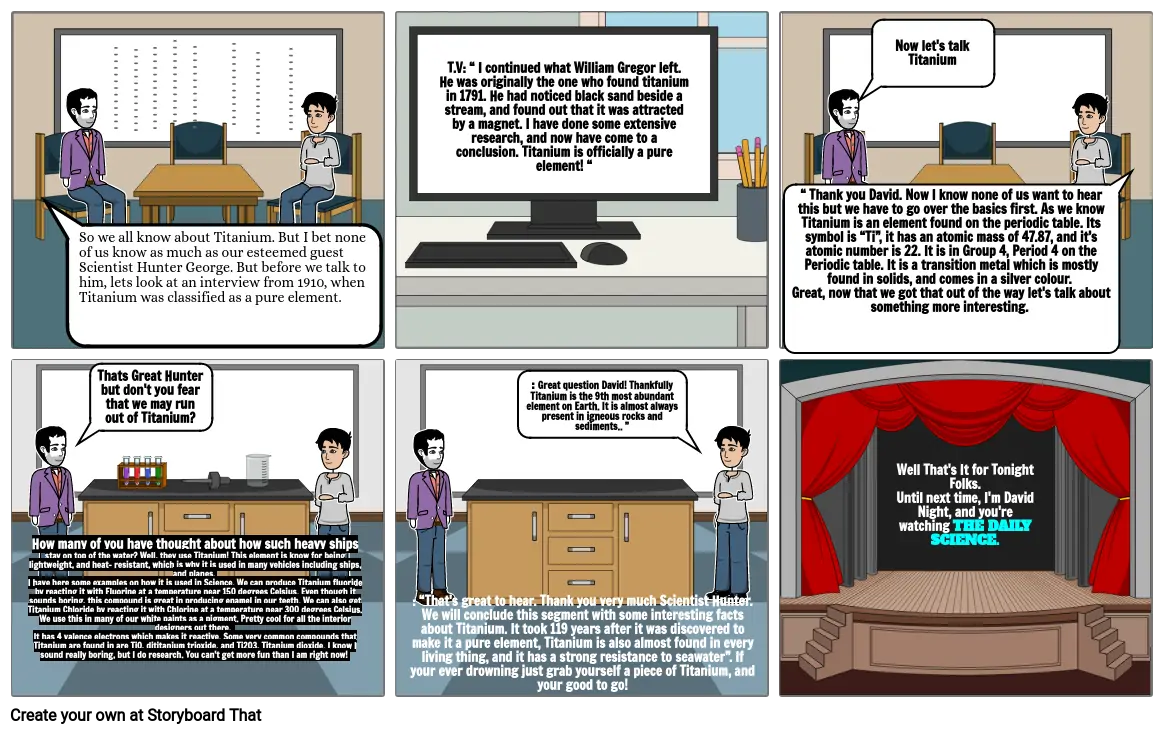Science Project

Texto del Guión Gráfico
- So we all know about Titanium. But I bet none of us know as much as our esteemed guest Scientist Hunter George. But before we talk to him, lets look at an interview from 1910, when Titanium was classified as a pure element.
- T.V: “ I continued what William Gregor left. He was originally the one who found titanium in 1791. He had noticed black sand beside a stream, and found out that it was attracted by a magnet. I have done some extensive research, and now have come to a conclusion. Titanium is officially a pure element! “
- “ Thank you David. Now I know none of us want to hear this but we have to go over the basics first. As we know Titanium is an element found on the periodic table. Its symbol is “Ti”, it has an atomic mass of 47.87, and it’s atomic number is 22. It is in Group 4, Period 4 on the Periodic table. It is a transition metal which is mostly found in solids, and comes in a silver colour. Great, now that we got that out of the way let's talk about something more interesting.
- Now let's talk Titanium
- How many of you have thought about how such heavy ships stay on top of the water? Well, they use Titanium! This element is know for being lightweight, and heat- resistant, which is why it is used in many vehicles including ships, and planes. I have here some examples on how it is used in Science. We can produce Titanium fluoride by reacting it with Fluorine at a temperature near 150 degrees Celsius. Even though it sounds boring, this compound is great in producing enamel in our teeth. We can also get Titanium Chloride by reacting it with Chlorine at a temperature near 300 degrees Celsius. We use this in many of our white paints as a pigment. Pretty cool for all the interior designers out there. It has 4 valence electrons which makes it reactive. Some very common compounds that Titanium are found in are TiO, dititanium trioxide, and Ti2O3, Titanium dioxide. I know I sound really boring, but I do research. You can’t get more fun than I am right now!
- Thats Great Hunter but don't you fear that we may run out of Titanium?
- : “That's great to hear. Thank you very much Scientist Hunter. We will conclude this segment with some interesting facts about Titanium. It took 119 years after it was discovered to make it a pure element, Titanium is also almost found in every living thing, and it has a strong resistance to seawater”. If your ever drowning just grab yourself a piece of Titanium, and your good to go!
- : Great question David! Thankfully Titanium is the 9th most abundant element on Earth. It is almost always present in igneous rocks and sediments.. ”
- Well That's It for Tonight Folks.Until next time, I'm David Night, and you're watching THE DAILY SCIENCE.
Más de 30 millones de guiones gráficos creados

